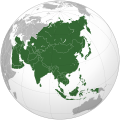| Subprovince | Age | Dominating rock | Possible tectonic event | Mineral deposit |
|---|
| Western Superior Province |
| Northern Superior Superterrane (NSS) | | - Granitic and gneissic rocks [15] - Mafic-intermediate volcanic rocks [4] [16] [17] - Minor greywacke [4] [16] [17] | - Granitoid magmatism [18] - Amphibolite-forming metamorphism caused by tectonic accretion [4] | - Lode gold deposits [19] - Diamond-containing kimberlite pipes [19] |
| Oxford-Skull Domain (OSD) | | - Basalt (Hayers River Assemblage) [20] - Volcaniclastic rocks (Oxford Lake assemblage) [20] - Underlain by tonalitic, granodioritic, granitic pluton with mafic intrusion [4] | - Oceanic setting [4] - Sealed the sediment after the collision of NSS and NCS [4] | - Lode gold deposits [21] (like Monument Bay gold deposit) |
| North Caribou Superterrane (NCS) | | - Plutonic base overlain by arc sequences [22] - Pervasive granitic to tonalitic pluton in the central region [4] | - Dominating plutonism [4] - Rifting in the southern margin [4] | - Gold deposits (like Red Lake Gold Camp) [4] - Massive sulphide deposits [23] |
| English River Domain (ERT) | | - Sedimentary rocks like wackes [24] - Amphibolite and low-pressure granulite [4] [25] - Migmatite and diatexite [26] | - Related to the suture of the NCS and WRT [26] | / |
| Winnipeg River Terrane (WRT) | | - Gneiss and foliated tonalite [27] [28] [29] - Granite [28] | - Tonalitic plutonism followed by granitic plutonism [4] | - Iron deposits [4] [30] - Native silver deposits [4] [30] |
| Wabigoon Terrane (WwT/EwT) | | - Mafic volcanic rocks and tonalitic pluton in the West [31] - Greenstone belts intruded by granitoid pluton in the East [4] | - Oceanic arc setting in the West [32] [33] [34] [35] - Continental margin setting in the East [36] | / |
| Quetico Terrane (QT) | | - Mainly greywacke, migmatite, granite [4] - Metarsedimentary successions intruded by tonalite, [4] nepheline, syenite, carbonatite [37] and granite [38] | - Ancient forearc [31] [39] [40] | / |
| Wawa Terrane (WT) | | - Calc-alkalic to alkalic rocks [41] - Sanukitoids [4] | - Oceanic tectonic mélange [42] [43] [44] | - Michipicoten-Mishubishu belt (Fe, Au, Cu and minor Ni) [45] - Shebandowan-Schreiber belt (Fe, Au, [45] VMS, [46] Ni) [47] |
| Kapuskasing Uplift (KU) | | - Tonalite, paragneiss and anorthosite | - Intracratonic Uplift [48] | / |
| Eastern Superior Province |
| Abitibi Terrane (AT) | | - North: Layered-intrusion-related volcanic rocks [4] [49] - Central: Plutonic rocks and minor volcanic rocks [50] - South: Younger greywackes, conglomerate and alkaline volcanic rocks [51] | / | - North: Massive sulphide deposits, Cu-Zn vein deposits, lode gold deposits [4] - Central: Massive sulphide deposits and vein gold deposits [50] - South: Gold deposits, Cu-Zn massive sulphide deposits, intrusive Ni deposits, and minor porphyry deposits [4] [52] |
| Pontiac Terrane (PT) | | - North: schists and paragneiss [53] - South: volcanic rocks [53] | - Fold-thrust belt [54] | - Quartz-vein-hosted gold deposits [4] - Gabbroic-sill-hosted Ni-Cu sulphide deposits [4] |
| Opatica Subprovince (OcS) | | - Tonalite, granodiorite, granite and pegmatite [55] [56] [57] | - West-verging shearing followed by south-vergent movement [57] | - Volcanogenic massive sulphide (VMS) deposits, Cu-Au vein deposits, Intrusion-hosted Ni-Cu deposits and iron formation [4] |
| Opinaca Subprovince (OnS) | | - metagreywacke [58] - massive leucogranite intrusion [59] | / | - Rare metals in peraluminous granites and pegmatites [4] |
| Ashuanipi Complex (AC) | | - Tonalite and diorite [60] - Granulite [61] - Intrusion of diatexite, [61] syenite, granodiorite and granite [4] [62] | / | / |
| La Grande Subprovince (LG) | | - Gneissic basement [63] - komatiites [4] | / | - Porphyry and igneous mineralization [4] |
| Bienville Subprovince (BS) | | - North: granitic and granodioritic intrusions [64] - South: massive granodioritic complex [64] [65] | / | / |
| Northeastern Superior Province(NESP) | | - I: tonalite and tonalitic gneiss [4] - II: pyroxene-bearing plutonic rocks [4] - IV: metasedimentary and pyroxene-bearing pluton [66] - V: pyroxene-bearing pluton with minor tonalite [4] - VI: magnetic pyroxene-bearing pluton [67] - VII: tonalitic complex [7] [6] | / | - Syngenetic: Algoma-type iron formation, volcanogenic massive sulphide, Ni-Cu deposits, Fe-Ti-V deposits (hosted by mafic intrusions), and U-Th-Mo bearing porphyry deposits [4] - Epigenetic: Cu, Ni, Ag, Au, rare earth elements (REE) and limited U deposits [4] |



















